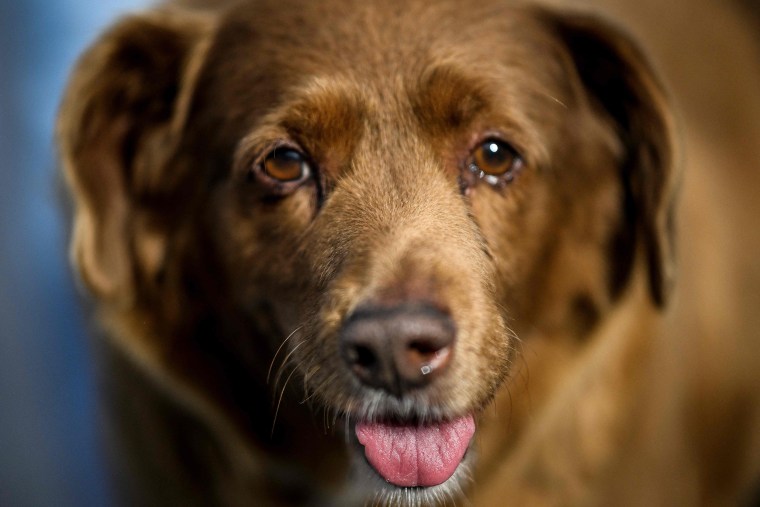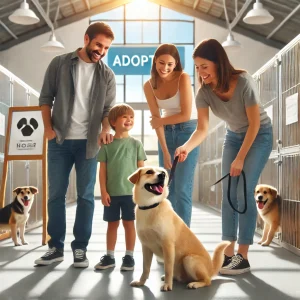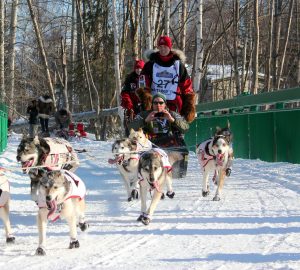
[ad_1]

What are the primary issues to coach a pet? I’ve seen so many lists. Behaviors on the door hardly ever make the highest 5 as a result of there are such a lot of different vital issues! However I work on doorways early on as a result of I’ve all the time had a family with a number of canine. My canine have to discover ways to reply to my visitors route. That is one thing I take totally without any consideration till there’s a new dog in the house. Whoops! I make the sleek “go forward” movement with my hand, indicating to the pup to go forward into the subsequent area (room, crate, exterior) and get a clean look. Or, in Lewis’ case, a gleeful leap to seize my hand or sleeve. Yay, this should be a tug recreation!
I wanted to work on this straight away. Lewis isn’t a child I can lug round. And from the very starting, I wanted to separate him from Clara loads. She likes him, and he has introduced a lot to her life, however “cruel pestering” isn’t a part of what brings her pleasure.
Each Out and In
It’s on nearly everyone’s checklist to finally educate canine to wait at the door, which is usually adopted by a launch to undergo. For me, when it’s the again door for a loo break within the yard, they get launched to undergo. However when it’s the entrance door and I’m going out to get the mail, it’s a wait adopted by a launch inside after the door is closed.
For this sort of “ready on the door” conduct, I take advantage of Sue Ailsby’s “Door Zen” methodology. Extra on that later. As a result of even earlier than I educate a canine to attend on the door, which is a reasonably superior conduct, I educate going by way of the door on cue, which is considerably simpler. Concomitantly, stopping a canine from going out a door by way of administration is fairly simple, however attempting to get them to undergo one which doesn’t have something attractive on the opposite aspect is surprisingly arduous, particularly in the event that they do not know about hand indicators.
Going into One other Area
I imagine I first noticed this pet train performed by Susan Garrett. She used two canine beds (good antecedent arrangement with the comfortable beds) to assist one in all her very younger puppies study to go from one to the opposite with hand gestures, somewhat luring, and naturally, a stunning reinforcer for doing the conduct. I did that actual train with Clara when she was additionally a child. After she would go from one canine mattress to a different on cue, I constructed it into “get in your mat” and “go into your crate” and “undergo the door” cues. It stood me effectively with three different canine in the home.
Lewis is a youngster and already has habits and a thoughts of his personal. He learns quick, however he’s not a malleable child. I did one session going from one canine mat to a different with reasonable success, then skipped forward to doorways themselves. I felt like going by way of a door is likely to be simpler to “clarify.”
I selected a impartial door in my home with equivalently boring environments on both aspect. I stood with him on one aspect of the open door, spoke my cue for going by way of (“Go forward”), and tossed a deal with underhand by way of the door. He chased it, as I hoped.
However the first few repetitions have been somewhat tough. He was not conversant in deal with tossing however paid shut consideration to fingers for an additional motive (seize them!). So it took some time for him to understand I used to be throwing one thing. I stored my actions easy and used kibble on a hardwood ground so it made some noise. After he realized I used to be tossing treats, he nonetheless wanted numerous apply to search out them. That is additionally a ability canine study as we educate them issues. It’s much more of a problem with child puppies as a result of they’re studying coordination as effectively, however there are nonetheless challenges for a succesful adolescent.
Canine have to study to observe treats transfer to be able to discover and seize them rapidly. Their imaginative and prescient is attuned very effectively for motion, however their colour detection is relatively weak. Brown items of kibble sitting on a brown ground necessitate a search social gathering, so it’s rather more environment friendly to look whereas the deal with is in movement. I additionally performed thrown deal with video games in different contexts, and Lewis began to catch on. He quickly determined this door stuff was a reasonably good recreation. After he went by way of the door to chase down the deal with, I beckoned him again with one other deal with or a hand goal and we did it once more.
So it appeared like this:
- “Go forward”
- Easily toss deal with
- Canine goes by way of, finds and eats deal with
- I get him again
- Repeat
We did a pair dozen of these. Then I switched to giving the hand sign with one hand and tossing the deal with with the opposite hand with a smaller hand movement and a really slight delay. This was a tiny step towards fading the lure and went high-quality.
Then one time I gave the verbal cue, made the underhand movement of tossing a deal with, however didn’t toss. He went by way of the door, and I adopted. Earlier than he began trying round, I popped a deal with into his mouth. This labored as effectively. I converted to only the verbal cue and hand movement with out throwing. If the conduct appeared somewhat wobbly, I’d do the subsequent rep with an actual tossed deal with.
What’s Actually Occurring Right here?
I can’t resolve whether or not my methodology is sloppy or elegant. In a single sense, I’m lumping. With Lewis, I taught a naïve canine about discovering thrown treats on the ground, a verbal cue, and a hand sign all on the similar time. I used a lure method longer than you’re “imagined to” earlier than fading it. However it labored effectively. The timing is vital, and I’m cautious about that. I all the time give the verbal first, adopted by the hand sign. The hand sign is probably going simpler for the canine to study, so the verbal coming first turns into the “new cue” in a model of the “new cue old cue” methodology, although they’re each launched in the identical classes.
This methodology works for me however test into books about a number of canine households by skilled trainers for higher vetted strategies for visitors route! My aim on this put up is to speak by way of the problems greater than to suggest my very own course of. I haven’t skilled sufficient canine to know whether or not it has a excessive probability of working for many.
Yet another factor. Talking {of professional} trainers, I’ll embody yet one more title right here. This methodology additionally “unintentionally” teaches a robust reorientation to the handler after the canine goes by way of the door, particularly for those who use high-value reinforcers. (The reinforcer and reinforcement historical past must compete with no matter is on the opposite aspect of the door.) Leslie McDevitt recommends this reorientation as a default conduct for canine when getting into new areas with their individual.
I haven’t gotten this cue as much as whole power with any canine, however “Go forward” in my family has come to imply “undergo the door earlier than me however instantly flip round and reorient to me afterward.” So whereas I wouldn’t take a look at if off leash when getting a canine out of a automotive in a brand new place, I can use it for issues like cuing the canine to enter the closed storage however flip round so I can put her harness on earlier than we go on our stroll. My canine have all acknowledged the distinction between a normal launch into the brand new area and the “undergo however flip round” cue. However I received’t guess their lives on it. I may positively work it as much as be stronger, although. In all probability a good suggestion with Lewis.
Strengthening that behavioral response would imply upping the worth of my reinforcers. I’ll do it sooner or later, however since I’m not taking Lewis to the mall anytime quickly, I’ll save excessive worth stuff for recall and studying to like his crate.
Ready on the Door
I can’t go into as a lot element right here. I observe Sue Ailsby’s protocol from the Training Levels, as I discussed. You possibly can see the primary couple of steps within the video. The handler touching the door deal with turns into the cue for the canine to orient to the handler and keep again from the door till launched.
Sue classifies ready on the door as a Zen train, Stage 3. (Sue, I’ve additionally been engaged on Stage 1—I promise!) Zen teaches a canine another conduct to one thing else they actually need to do (seize the meals, run out the door) and makes it value their whereas. And with doorways, generally they do get that final reinforcer of operating by way of.
Combining the Two Behaviors
As you’ll be able to see within the film, I can use the 2 cues in sequence. I first use the “wait on the door” cue, which is grabbing the deal with. By the point I recorded the video, I had taught Lewis to remain again once I open the door vast. Then I can provide the “go forward” cue to ship him by way of.
Word: It’s vital to apply loads with out sending the canine by way of. In actual life there will probably be loads of conditions the place you’ll want to go first, or the canine doesn’t undergo in any respect. Don’t educate these two behaviors as a unit the place the canine is all the time launched by way of the door. Bear in mind the Matching Legislation and do tons and tons of reps the place the canine stays within the room whilst you undergo the open door.
Lewis Discovered Quicker Than I Did
One thing humorous occurred with Lewis, and it took me some time to determine it out. I haven’t used both of those newly realized behaviors in real-life conditions but, or so I believed. Lewis has, although!
I’ve talked about that when he first got here, I couldn’t get him to undergo doorways with a hand movement as a result of he centered on the hand itself. That was apparently so he may soar within the air and chew it. However that has already modified. After I open random doorways in the home and maintain them open for the canine, Clara will undergo. Lewis received’t. I’ll stand there holding the door open, ready for him. Now what? I lastly realized: he has observed my hand on the door deal with and is responding to that cue by stopping and taking a look at me. Precisely what I skilled—I simply wasn’t anticipating it in actual life this quickly. As Sue Ailsby would say, “Oops, I broke my canine!”
I do find it irresistible once they make it clear how a lot sooner they study than I do!
Associated Submit
You Don’t Have to Go Through the Door Before Your Dog!
Copyright 2022 Eileen Anderson
[ad_2]
Source link











